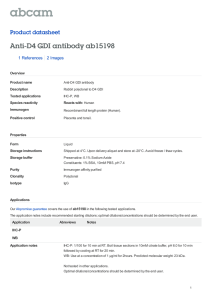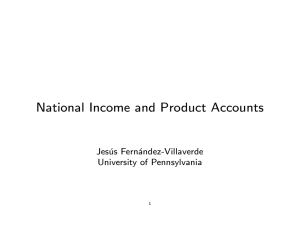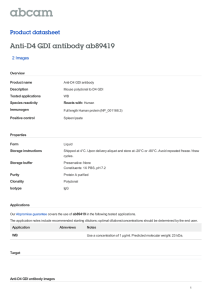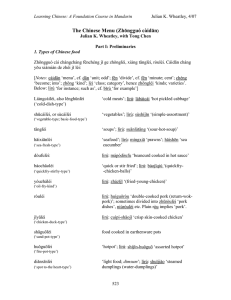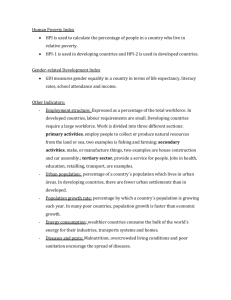The Chinese Menu (Zhōngguó càidān
advertisement
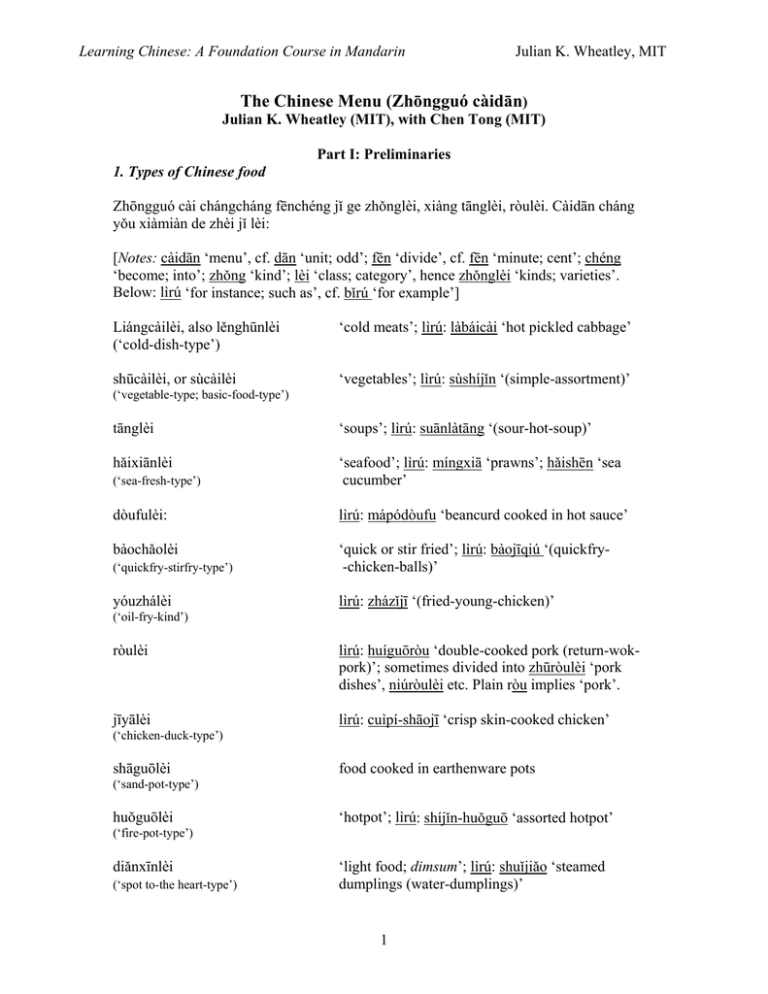
Learning Chinese: A Foundation Course in Mandarin Julian K. Wheatley, MIT The Chinese Menu (Zhōngguó càidān) Julian K. Wheatley (MIT), with Chen Tong (MIT) Part I: Preliminaries 1. Types of Chinese food Zhōngguó cài chángcháng fēnchéng jǐ ge zhǒnglèi, xiàng tānglèi, ròulèi. Càidān cháng yǒu xiàmiàn de zhèi jǐ lèi: [Notes: càidān ‘menu’, cf. dān ‘unit; odd’; fēn ‘divide’, cf. fēn ‘minute; cent’; chéng ‘become; into’; zhǒng ‘kind’; lèi ‘class; category’, hence zhǒnglèi ‘kinds; varieties’. Below: lìrú ‘for instance; such as’, cf. bǐrú ‘for example’] Liángcàilèi, also lěnghūnlèi (‘cold-dish-type’) ‘cold meats’; lìrú: làbáicài ‘hot pickled cabbage’ shūcàilèi, or sùcàilèi ‘vegetables’; lìrú: sùshíjǐn ‘(simple-assortment)’ (‘vegetable-type; basic-food-type’) tānglèi ‘soups’; lìrú: suānlàtāng ‘(sour-hot-soup)’ hǎixiānlèi (‘sea-fresh-type’) ‘seafood’; lìrú: míngxiā ‘prawns’; hǎishēn ‘sea cucumber’ dòufulèi: lìrú: mápódòufu ‘beancurd cooked in hot sauce’ bàochǎolèi (‘quickfry-stirfry-type’) ‘quick or stir fried’; lìrú: bàojīqiú ‘(quickfry-chicken-balls)’ yóuzhálèi lìrú: zházǐjī ‘(fried-young-chicken)’ (‘oil-fry-kind’) ròulèi lìrú: huíguōròu ‘double-cooked pork (return-wokpork)’; sometimes divided into zhūròulèi ‘pork dishes’, niúròulèi etc. Plain ròu implies ‘pork’. jīyālèi lìrú: cuìpí-shāojī ‘crisp skin-cooked chicken’ (‘chicken-duck-type’) shāguōlèi food cooked in earthenware pots (‘sand-pot-type’) huǒguōlèi ‘hotpot’; lìrú: shíjǐn-huǒguō ‘assorted hotpot’ (‘fire-pot-type’) diǎnxīnlèi (‘spot to-the heart-type’) ‘light food; dimsum’; lìrú: shuǐjiǎo ‘steamed dumplings (water-dumplings)’ 1 Learning Chinese: A Foundation Course in Mandarin Julian K. Wheatley, MIT miànlèi: Miàn generally means noodles or pasta made from wheat flour, but it may also include, eg: mǐfěn ‘riceflour noodles’, also called héfěn and, in Southeast Asia, guōtiáo ['Kwey Teow' in Hokkien]. Cf. tāngmiàn ‘noodle soup’ distinguished from lāomiàn ‘(ladled+out-noodles)’ ie lomein, served without the soup. Lìrú: niúròumiàn ‘beef noodles’. zhǔshílèi, sometimes fànlèi dishes served on or with rice, lìrú: chāshāo-chǎofàn ‘roast pork-fried-rice’ (‘main-food-type’) tānglèi ‘soups’; lìrú: dànhuātāng ‘egg-flower-soup; eggdrop soup’ tiándiǎnlèi ‘desserts’, traditionally not a major category. Lìrú: bābǎofàn ‘8-valuables-rice’ a pudding with rice, fruit and nuts. 2. The names of dishes a) Descriptive names, in which the parts give some clue to the dish chǎojīdīng ‘stirfried-chicken-cubes’ zhácài-ròusī-tāng ‘picked cabbage-meat shreds-soup’ hǎishēn-běigū-pádàyā ‘sea cucumber-northern mushrooms-braised big duck’ b) Dishes incorporating proper names: Yángzhōu-chǎofàn ‘Yangzhou friend rice’ [Yángzhōu on the Yángzijiāng, or Cháng Jiāng east of Nánjīng] Dōngpōròu ‘Dongpo’s pork’, a fatty pork dish associated with – and possibly created by – the Song dynasty poet Sū Shì, generally known as Sū Dōngpō ‘Su of the east bank’ [of the Yangtze, the site of his house.] Xīhú-cùyú ‘(West Lake-vinegar fish)’ [West Lake, in Hángzhōu] c) Dishes with numbers: èrdōng, sānxiān, bābǎo, sānzhēn shāo'èrdōng, ‘cooked-2-winters’; the two are usually dōnggū ‘wintermushrooms’ and dōngsǔn winter-bamboo-shoots’ 2 Learning Chinese: A Foundation Course in Mandarin Julian K. Wheatley, MIT sānxiān-hǎishēn, ‘3 freshes-seaslug’, ie sea cucumber (actually an animal), plus, eg shredded pork, bamboo shoots, and chicken gānbèi-sìsī ‘scallops-4 shreds, ie ‘scallops + 4 meats/vegetables’. d) Poetically or allusively named dishes máyǐ-shàngshù ‘ants-climb-tree’; spicy ground beef sauce poured over deep fried ‘bean threads’ (fěnsī). The dish is named for the black specks that appear on the noodles. shīzitóu ‘lion-head’; large meatballs stewed with cabbage leaves, reminiscent of a lion’s head. Zuǒgōngjī ‘Zuǒ-duke-chicken’, often called ‘General Zuo’s chicken’; a dish said to have been created in America by a cook from the Cantonese region. Luóhàn-pádàyā Luóhàn < Skt. arahant; ‘Buddhist saint-braised-big-duck’ Fótiàoqiáng ‘Buddha-jumps-wall’; a stew of meats and dried ingredients served in a big wine jar. A Fujianese dish. e) Chinese dishes are almost all associated with a region or a regional cuisine, but some have special associations with particular places, and are promoted as such – as dìfāng fēngwèi cài. guòqiáo-mǐxiàn: ‘cross bridge-rice strands’; associated with Kūnmíng, Yúnnán. Máojiācài: ‘Mao-home-dishes’; Hunan countryside dishes, supposedly the sort of things that Mao Zedong enjoyed growing up, eg hóngshāoròu ‘braised beef’. gǒubulǐ bāozi: ‘dog-not-obey dumplings’; from Tianjin. ěrduo-yā-zhágāo: ‘ear-duck-fried cakes’; sweet and deep fried ‘cake’, another specialty of Tianjin. yángròu-pàomò: ‘lamb meat-broth’; a specialty of Xi’an. yānròu ‘salted pressed pork’; associated with Zhènjiāng in Jiāngsū. 3 Learning Chinese: A Foundation Course in Mandarin Julian K. Wheatley, MIT 3. Some specialized menu terms shíjǐn 什錦 hóng 紅 yúxiāng 魚香 chǐzhī 豉汁 chǐjiāo 豉椒 gālí 咖喱 háoyóu 蠔油 gōngbǎo 宮保 jiàngbào 醬爆 sānsī 三絲 èrdōng 二冬 shícài 時菜 málà 麻辣 zhēn jiācháng 珍 家常 ‘assortment of; mix of’; sometimes represented on menus as subgum, a spelling based on the Cantonese pronunciation. ‘red’, usually meaning ‘cooked in soysauce’; cf. hóngshāo ‘redcooked’, ie simmered in soysauce. ‘fish-scented = tasty’; a garlic sauce. a black bean sauce ‘black bean-peppers’ ‘curry’ ‘oyster sauce’ ‘palace-keep’; cooked with chilies and peanuts. ‘sauce-quickfried’; usually means cooked with a bean-paste sauce. ‘three-shredded' ‘two-winter [vegetables]’; also shuāngdōng ‘pair of winter’. ‘seasonal vegetables (time-vegetables)’ ‘numb-spicy hot’; cooked with huājiāo ‘Sichuan pepper’, chili, and sesame oil. ‘treasure’; usually means ‘giblets’. ‘home-frequent’, ie home-style. 4. The 8 Chinese cuisines (bā ge càixì) Zhōngguó bù tóng dìfang yǒu bù tóng de wèidào, bù tóng de zuòfǎ, bù tóng de chīfǎ. Bǐfāng shuō, Guǎngdōng fùjìn yǒu Guǎngdōng cài, Shànghǎi fùjìn yǒu Shànghǎi cài. Zhōngguó rén píngcháng shuō Zhōngguó cài yǒu bā ge càixì. [-fǎ ‘way of …’; càixì ‘food-systems’; biéchēng ‘other name’; bāokuò ‘include’; huángdì ‘emperor’] Shāndōng cài: yě jiào Lǔ cài; Lǔ shi Shāndōng de biéchēng. Shāndōng cài yě bāokuò Běijīng cài. Guǎngdōng cài: yě jiào Yuè cài. (Yuè shì Guǎngdōng de biéchēng.) Sìchuān cài: yě jiào Chuān cài. (Chuān shì hé de yìsi; Sìchuān yǒu sì tiáo hé; Chuān jiùshi Sìchuān de biéchēng.) 4 Learning Chinese: A Foundation Course in Mandarin Jiāngsū cài: Julian K. Wheatley, MIT yě jiào Huáiyáng cài. (Huái shì Huái Hé; Yáng shì Yángzhōu – dōu zài Jiāngsū.) Zhèjiāng cài yě jiào Zhè cài. ~ Shànghái cài Ānhuì cài: yě jiào Wǎn cài. (Wǎn shi Ānhuì de biécheng.) Húnán cài: yě jiào Xiāngcài. (Xiāng shì Húnán de biéchēng.) Fújiàn cài: yě jiào Mǐn cài. (Mǐn shì Fújiàn de biéchēng; Táiwān cài shi Mǐn cài de yì zhǒng.) Zhèi bā ge càixì, zuì yǒumíng de zuì pǔbiān de yěxǔ shì Lǔ cài, Yuè cài, Chuān cài, hé Xiāng cài. Chúle nèi bā ge càixì yǐwài, yě yǒu jǐ ge tèbié de, xiàng: gōngtíng cài: ‘palace food’; shi huángdì chī de, hěn tèbié, hěn guì. kǒngfū cài: ‘Confucius-residence food’; Yīnwéi Kǒngfūzǐ de lǎojiā shì Shāndōng, suǒyǐ kǒngfū cài hěn xiàng Shāndōng cài, huòzhě shì Shāndōng cài de yì zhǒng. qīnggzhēn cài: ‘Moslem food (qīngzhēn ‘clear-truth = Islam’); cf. qīngzhēnsì ‘a mosque’. Zhōngguó rén cháng shuō Zhōngguó dōng-nán-xī-běi de cài gè yǒu gè de wèidào. Tāmen shuō: nán tián, běi xián, dōng là, xī suān. Nà bú shi shuō nánbiān měi gè cài dōu shì tián de huòzhě běibiānr měi gè cài shi xián de, shì yìbān lái shuō dōu shì zhèi yàngr. [Notes: gè yǒu gè de [ ] ‘each has its own [ ]’; měi ge cài ‘each dish’; yìbān ‘general; ordinary; common’; yìbān lái shuō ‘generally speaking’] 5. Methods of cooking (pēngtiáo fangfǎ) Zhōngguó rén yě shuō Zhōngguó cài yǒu xiē zhǔyào de zuòfǎ – yě jiùshi shuō pēngtiáo fāngfǎ: [Notes: zhǔyào ‘main; chief; major’; pēngtiáo fāngfǎ ‘methods of cooking’] jiān chǎo zhá bào ‘shallow-fry [in a little oil]’; jiānyú ‘fried fish’ ‘stirfry [in a little oil]’; chǎofàn; chǎomiàn ‘deepfry [in deep, hot oil]’; zhájī ‘fried chicken’ ‘quickfry’; bàoyāohuār ‘(quickfry- kidney-flower)’ 5 Learning Chinese: A Foundation Course in Mandarin pēng shāo dùn zhēng huì bá ~ pá zhǔ kǎo tángcù hóngshāo bàn xūn kòu jiàng cuān Julian K. Wheatley, MIT ‘sautee [in very hot oil]’; pēng dàxiā ‘sauteed prawns’ ‘fry in light vegetable oil, stirring’; shāosānsī ‘cook-3-shredded’ ‘boil in water, low heat; stew’; dùnniúròu ‘stewed beef’ (or qīngzhēng) ‘steam over water’; qīngzhēngyú ‘steamed fish’ ‘boil in water and (thicken with) soy sauce’; huìxiārénr ‘braised shrimp’ ‘boil or steam, then thicken with starch’; páhǎishēn ‘braised sea-cuke’ ‘boil; cook [general term]’; shuǐzhǔ-niúròu ‘boiled beef’ [Sìchuān cài] ‘bake; roast; toast’; kǎomiànbāo ‘toast’; kǎoyā ‘ roast duck’ ‘(sugar-vinegar) deep fry, then add sweet and sour sauce’; tángcùyú ‘(red-cook) boil in soysauce; braise’; hóngshāo-qiézi ‘braised eggplant’ ‘mix’, especially of various cold appetizers; bànhǎizhé ‘mixed jellyfish’ ‘to smoke [food] after boiling’; xūnyú ‘smoked fish’ ‘steam in a mold’; kòuròu ‘potted meat’ ‘boil in a little soysauce’; jiàngbào-jīdīng ‘fried chicken cubes’ ‘boil in soup for a short time’; cuānwánzi ‘boiled-meat-balls’ 6. Spices and seasonings (zuóliào) Zhōngguó cài bǐjiào cháng yòng de zuóliào: cōng suàn liàojiǔ táng yóu diànfěn làjiāo ‘onions’ ‘garlic’ ‘cooking wine’ ‘sugar’ ‘oil’ ‘starch’ ‘chillies’ jiāng jiàngyóu yán cù xiāngyóu; máyóu huājiāo ‘ginger’ ‘soy sauce’ ‘salt’ ‘vinegar’ ‘sesame oil’ ‘Sichuan pepper’ 7. Ways of cutting ( qiēfǎ ) dīng piàn sī qiú ‘cubes’; ‘slices’; ‘shredded’; ‘ball; curl’; jiàngbào-jīdīng ‘fried chicken cubes’ yúpiàn ‘sliced fish’ ròusī-chǎomiàn ‘fried noodles with shredded pork’ chǎoxiāqiú ‘fried shrimp balls [‘curls of shrimp’] 8. Tools (gōngjù), with example sentences Vocabulary shícài náshǒu cài gěi wǒ tuījiàn […] diǎn (cài) zài lái [ ] féi sùcài ‘seasonal food (timely-food)’ ‘special; expert; signature [dishes] (take-hand)’ ‘recommend […] for me’ ‘order [food]; also jiào [cài] ‘bring another [ ]’ ‘fatty; rich; sleek’ ‘vegetarian food (simple-food)’ 6 Learning Chinese: A Foundation Course in Mandarin Julian K. Wheatley, MIT càidān Qǐng gěi wǒ càidān kànkan. menu (dish-list): May I look at a menu please. kuàizi Qǐng gěi wǒ lái yí fù kuàizi. Shǎo le yífù kuàizi. chopsticks May I have a set of chopsticks, please. [We]’re short a pair of chopsticks. dāochā; dāozi; cházi Zài lái yì bǎ dāozi, zhèi bǎ bù gānjìng knifes and forks Bring another knife, this one’s dirty. sháor; sháozi; tángsháor; yí ge sháor Méiyou sháor, bù néng hē tāng! ‘spoon’ Without a spoon, [you] can drink soup. bēizi Máfan nǐ zài lái ge bēizi, zhèi ge shi pòliè de! ‘cup; glass’ May I trouble you for another glass – this one’s cracked! guō wǎn pán; pánzi cānjīn yì wǎn; yí ge wǎn yì pán; yí ge pánzi ‘pot; pan; frying pan’ ‘bowl of; bowl’ ‘plate of; plate, tray, dish’ ‘napkin (food-towel)’ 9. Usage (shuōfǎ) Nǐmen zhèr yǒu shénme shícài? What seasonal vegetables do you have [here]? Nǐmen zhèr yǒu shénme náshǒu cài? What specialties do you do here? Wǒ yí ge rén; néng bu néng gěi wǒ tuījiàn nǐmen yí ge bǐjiào náshǒu de cài. I’m alone; could you recommend one of your better dishes? Mǎidān ba; zhàngdān ba. The bill/check please. In recent years, the Cantonese mǎidān ‘buy-list’ seems to have gained ground over zhàngdān ‘account-list’. Gòu bu gòu sì ge rén chī? Enough for 4? Bú gòu wǒmen zài diǎn, hǎo ma? [If it]’s not enough, we’ll order more, okay? Sān ge cài yí ge tāng yīnggāi gòu ~ zúgòu. 3 dishes and a soup should be enough ~ sufficient. Zài lái yì wǎn báifàn. Bring another bowl of rice. 7 Learning Chinese: A Foundation Course in Mandarin Julian K. Wheatley, MIT Xiànzài, shénme yú zuì féi? What kind of fish is best [‘plump’] these days? Qǐng bú yào tài là. Not too hot please. Yǒu méiyou sùcài, wǒ bù chī ròu. Do you have any ‘vegetable dishes’ – I don’t eat meat. Zhēn qiàdào hǎochù! That really hits the spot! (‘appropriate-reach good-place’) 8 Learning Chinese: A Foundation Course in Mandarin Julian K. Wheatley, MIT Part II: Dialogue in a Restaurant A slightly exaggerated and idealized conversation. (Characters here, a pinyin version below.) 1. 在饭馆儿 王=主人;史密斯=客人;小姐=服务员 Wáng = zhǔrén; Shǐmìsī = kèrén; xiǎojiě = fúwùyuán 王 老史,今天想吃(一)点儿什么? Lǎo Shǐ… 史 随便,随便。 Suíbiàn, suíbiàn. 王 哎,别随便啊,今天给你接风! 我请客,你就别客气了。放心地 点菜,喜欢吃什么就点什么。 Ai, …….gěi nǐ jiē fēng! 史 别,别,别太破费了,随便吃 一点儿得了。 Bié tài pòfèi le,… 那怎么行啊?你是远方来的客人, 不能怠慢了! …nǐ shì yuǎnfāng lái de 王 史 王 我不会点菜,还是你来吧。 我一到饭馆儿就傻!我客随 主便。 好吧,你喜欢吃海鲜呢?还是喜欢 吃肉类的菜? 史 平时吃的挺随便,主要是蔬菜。 王 那,咱先来几个素菜。小姐! 9 …déle! kèrén, bù néng dàimàn le! yī….jiù shǎ! Wǒ kèsuízhǔbiàn. …hǎixiān …ròulèi de cài? Píngshí chī de tǐng suíbiàn, zhǔyào shi shūcài. Nà, zá xiān lái jǐ ge sùcài. Learning Chinese: A Foundation Course in Mandarin Julian K. Wheatley, MIT 小 先生,点菜吗? 王 你们这儿的素菜哪个最拿手? 小 干煸四季豆,蚝油芥兰,荷兰豆, 香菇菜心,家常豆腐,素什锦。 王 小 zuì náshǒu? 那,就来个家常豆腐,素什锦, 荷兰豆。哎,小姐,你们这儿 有面筋吗? Gānbiān-sìjì-dòu, háoyóujièlán, hélándòu, xiānggūcàixīn, jiācháng-dòufu, sùshíjǐn. … miànjin 有,有冬瓜面筋,独面筋, 也有面筋白菜粉条。 yǒu dōngguā-miànjin, 王 来个独面筋吧。 …dúmiànjin 小 先生还要点什么? 王 四个素菜了。再来两个荤菜。 老史,你们在美国总吃牛肉, 对吗?那,来个龙须牛肉, 再来个蚝油牛肉。 史 行了,行了,太多了,两个人 吃不了! 王 没问题,吃得了。这点儿菜 都吃不了,那还叫男子汉吗? 再来两个海味儿的,一个 红烧目鱼,一个龙虾两吃。 小 先生,水酒要不要? 10 dúmiànjin, miànjin-báicàifěntiáo. sì ge sùcài le. Zài lái liǎng ge hūncài. … lóngxū-niúròu, … háoyóu-niúròu. … chīdeliǎo. … nà hái jiào nánzǐhàn ma? … hǎiwèir de, hóngshāo-mùyú, ... lóngxiā-liǎngchī. Learning Chinese: A Foundation Course in Mandarin 史 王 小 不要,不要,我一喝酒就上头 上脸儿,来点儿凉水就行了。 什么上头,上脸儿的?吃饭 哪儿有不喝酒的?在中国, 吃饭没有光喝凉水的!啤酒 也没什么劲儿。今天让我们 老史尝尝中国白酒。小姐, 你们这儿有什么名酒? Julian K. Wheatley, MIT shàng liǎnr, … liángshuǐ …. … guāng hē liángshuǐ de! … yě méi shénme jìnr. Jīntiān ràng wǒmen lǎo Shǐ chángcháng…. 我们什么名酒都有,有茅台, 有五粮液,蒙古王。 yǒu Wǔliángyè, Měnggǔwáng. 王 有小瓶儿的吗? … xiǎo píngr … ? 小 有二两装的和半斤装的。 Yǒu èr liǎng zhuāng hé bàn jīn zhuāng de. 王 半斤装的茅台和五粮液, 一样来一瓶儿。 yǒu Máotái, yíyàng lái yì píngr! 小 还要一点儿什么呢? 史 不要了,不要了,千万别再要了。 我看我今天非把肚子吃爆了不可! 王 哎,多年不见的朋友,我们今天 应该好好喝喝。 史 好,好,借这个机会好好聊聊。 … qiānwàn bié zài yào le. … fēi bǎ dùzi chībào le bù kě! …, jiè zhèi ge jīhuì hǎohǎo liáoliáo. (After Chen Tong, with minor modifications by JKW.) 11 Learning Chinese: A Foundation Course in Mandarin Julian K. Wheatley, MIT Shēngcíbiǎo zhǔrén gěi nǐ jiē fēng! jiē fēng host; kèrén de xiāngfǎn have a reception/party for you welcome s/o after a journey (meet-wind) Bié tài pòfèi le! Déle! yuǎnfāng Don’t incur expense/waste too much money! (break-expenses) That’s plenty/enough! (get-le) distant place; afar kèrén, bù néng dàimàn le! Dàimàn le! guests shouldn’t be neglected! I’m neglecting you -- not doing my duty. yī….jiù shǎ kèsuí-zhǔbiàn hǎixiān ròulèi Píngshí chī de tǐng suíbiàn, zhǔyào shi shūcài. zhǔyào as soon as….then helpless (idiotic) go along with (guest follow-host’s will); the expression is based on suíbiàn and the opposites zhǔ ‘host’ and kè ‘guest’. seafood (sea-fresh) meat (meat-category) I’m usually pretty simple in my eating, as long as [it]’s vegetarian dishes. SV ‘main; chief; major (host-need)’ Nà, zám xiān lái jǐ ge sùcài. diǎn cài zuì náshǒu? Okay, let’s have a few veg. dishes first. order food (indicate dishes) dishes you do best (most take-hand) gānbiān-sìjì-dòu jiācháng-dòufu sùshíjǐn. [Sichuan] ‘dry stirfry-4 seasons-beans’; dry cooked string beans, with seasonings, stir fried until liquid evaporates. broccoli in oyster sauce pea pods (Holland beans) mushrooms and flowering cabbage (fragrant mushroom-vegetable heart) home-cooked toufu (house-common toufu) vegetarian platter miànjin dōngguā-miànjin dúmiànjin miànjin-báicài-fěntiáo ‘gluten’, see note below winter melon gluten ‘solitary’ gluten gluten-bokchoy-bean noodles hūncài lóngxū-niúròu háoyóu-niúròu meat dishes asparagus beef (dragon beard-beef) beef with oyster sauce háoyóu-jièlán hélándòu xiānggū-càixīn 12 Learning Chinese: A Foundation Course in Mandarin Julian K. Wheatley, MIT nánzǐhàn hǎiwèir hóngshāo-mùyú lóngxiā-liǎngchī ‘a he-man’ seafood red-braised cod lobster two-eats shàng liǎnr liángshuǐ guāng hē liángshuǐ de! Píjiǔ yě méiyou shénme jìnr. chángchang Máotái Wǔliángyè Měnggǔwáng èr liǎng zhuāng Qiānwàn bié zài yào le. qiānwàn bié for the face to flush cold water [people] who only drink cold water And beer doesn’t have any kick. taste; try Maotai liquor a grain liquor (5 grain liquid) ‘Mongolian King’ [liquor] two ounces capacity Pleeease don’t order any more! absolutely don’t (1000-10,000 don’t) fēi bǎ dùzi chībào le bù kě! have to fill one’s stomach to bursting; cf. chībǎo ‘eat to fill’ but here, chībào ‘eat to bursting’. must; inevitably; no choice but to ([a double negative] not to….not okay) fēi ……..bù kě! Note on 面筋 miànjìn ‘gluten’: Barbara Tropp, in her book The Modern Art of Chinese Cooking: Techniques and Recipes, calls miànjin as a kind of ‘mock meat’, a category that covers ‘a variety of products made variously from wheat gluten and soybeans that are flavored and fashioned to resemble meat’ (p.553). 13 Learning Chinese: A Foundation Course in Mandarin Julian K. Wheatley, MIT 2. In a restaurant (pinyin version) Wáng [W] = the host; Shǐmìsī ‘Smith’ [Sm] = a guest; xiǎojiě [x] = the waitress W: Lăo Shǐ, jīntiān xiǎng chī yìdiănr shénme? Smith, my man, what would you like to have? Sm: Suíbiàn, suíbiàn. Oh, whatever. W: Hey, no ‘whatever-ing’, today we’re welcoming you! I’m inviting, so relax. Don’t worry about ordering, order whatever you like. Āi, bié suíbiàn a, jīntiān gĕi nĭ jiēfēng! Wŏ qĭngkè, nĭ jiu bié kèqi le. Fàngxīn-de diăn cài, xĭhuan chī shénme jiu diăn shénme. Sm: Bié, bié, bié tài pòfèi le, suíbiàn chī yìdiănr déle! Don’t spend too much, [let’s] just have a a little something and that’ll do! W: Nà zĕnme xíng a? Nĭ shi yuǎnfāng lái de kèrén, bù néng dàimàn le! What do you mean? You’re a guest, from a long way off, we can’t neglect our duty. Sm: Wŏ bú huì diăn cài, háishi nĭ lái ba. Wŏ yí dào fànguănr jiu shǎ! Wŏ kèsuí-zhǔbiàn. I can’t order, better you do it. I’m helpless whenever I get to a restaurant. I’ll just go along with you. W: Hăo ba, nĭ xĭhuan chī hăixiān ne? Háishi xĭhuan chī ròulèi de cài? Okay, do you like seafood? Or meat? Sm: Píngshí chī de tǐng suíbiàn, zhǔyào shi shūcài. Generally, I’m not at all fussy, I’m basically into vegetables. W: Nà, zánmen xiān lái jǐ ge sùcài. Xiăojiě! Okay, let’s have some vegetarian food first. Waitress! x: You’re ordering, sir? Xiānshēng, diăncài ma? W: Nĭmen zhèr de sùcài, něi ge zuì náshǒu? x: What’s your best vegetarian dish here? Gānbiān-sìjì-dòu, háoyóu-jièlán, hélán- Stirfried string beans, broccoli in oyster dòu, xiānggū-càixīn, jiācháng-dòufu, sauce, pea pods, mushrooms and flowering sùshíjĭn. cabbage, home-cooked toufu, veg. platter. W: Nà, jiu lái ge jiācháng-dòufu, sùshíjĭn, So, bring a home-cooked toufu, a veg. hélándòu. Āi, xiăojiě, nĭmen zhèr yǒu platter, and pea pods. Say, hon’, do you miànjin ma? have gluten here? 14 Learning Chinese: A Foundation Course in Mandarin x: Julian K. Wheatley, MIT Yǒu, yǒu dōngguā-miànjin, dúmiànjin, Yes, we have winter-melon gluten, plain yĕ yǒu miànjin-báicài-fěntiáo. gluten, and gluten-bokchoy-bean noodles. W: Lái ge dúmiànjin ba. Bring a plain gluten, okay? x: What else will you have, sir? Xiānshēng hái yǒu yìdiănr shénme? W: Sì ge sùcài le. Zài lái liăng ge hūncài. Lăo Shǐ, nĭmen zài Mĕiguó zǒng chī niúròu, duì me? Nà, lái ge lóngxūniúròu, zài lái ge háoyóu-niúròu. Sm: Xíng le, xíng le, tài duō le, liăng ge rén chībuliǎo! [That]’s 4 vegetable dishes. Bring two meat dishes as well. Smith, in America you always eat beef, right? So bring an asparagus beef, and a beef with oyster sauce as well. [That]’ll do, [that]’s too much, two people can’t eat that much. W: Méi wèntí, chīdeliǎo. Zhè diănr cài No problem, [we] can eat [it]. [Can] we dōu chīdeliǎo, nà hái jiào nánzǐhàn ma? still call [ourselves] men eating this little Zài lái liăng ge hǎiwèir de, yí ge bit of food? Bring two seafood dishes, a hóngshāo-mùyú, yí ge lóngxiābraised cod and a couple of lobster meals. liǎngchī. x: Xiānshēng, shuǐjiǔ yào bu yào? Do you want water and wine, sir? Sm: Bú yào, bú yào, wŏ yì hē jiŭ jiu shàngtou shàngliǎnr, lái diănr liángshuǐ jiu xíng le. No, no, whenever I drink it goes to my head and I get flushed; bring a couple of cold waters – that’ll be fine. W: Shénme shàngtou, shàngliǎnr de? Chīfàn nǎr yǒu bù hē jiŭ de? Zài Zhōngguó, chīfàn méiyou guāng hē liángshuǐ de! Píjiŭ yĕ méiyou shénme jìnr. Jīntiān ràng wŏmen lăo Shǐ chángchang Zhōngguó báijiŭ. Xiăojiě, nĭmen zhèr yǒu shénme míngjiǔ? What do you mean ‘goes to your head and your face’? How can you have a meal without wine? In China, we don’t just drink cold water. And beer’s not strong enough. Today, let’s have Mr. Smith try some Chinese white-liquor. Miss, what sort of well known wines do you have here? x: We have all the well-known wines, Maotai, 5-Grain, Mongol King. Wŏmen shénme míngjiǔ dōu yǒu, yǒu Máotái, yǒu Wŭliángyè, Měnggǔwáng. W: Yǒu xiǎopíngr de ma? Do you have small bottles? x: We have 2 ounce bottles and half-jin bottles. Yǒu èr liăng zhuāng de hé bàn jīn zhuāng de. 15 Learning Chinese: A Foundation Course in Mandarin Julian K. Wheatley, MIT W: Bàn jīn zhuāng de Máotái hé Wŭliángyè, yí yàng lái yì píngr. A half-jin bottle of Mao Tai and 5-Grain, one of each. x: And what else? Hái yào yìdiănr shénme ne? Sm: Bú yào le, bú yào le, qiānwàn bié zài yào le! Wŏ kàn wŏ jīntiān fēi bǎ dùzi chībào le bù kě! Nothing else, pleeease, nothing else! Looks like my stomach’s going to explode for sure today! W: Āi, duōnián bú jiàn de péngyou, wŏmen jīntiān hăohăo hēhe. Hey, [it]’s been years since we friends saw [each other], we should have a proper drink. Sm: Hăo, hăo, jiè zhèi ge jīhuì hăohăo liáoliao. Okay, [let]’s take this opportunity to have a good chat! 16 Learning Chinese: A Foundation Course in Mandarin Julian K. Wheatley, MIT Part III. Sample menu items 菜单/菜單 1. Lěnghūnlèi = lěngcàilèi ‘(cold) appetizers’ 冷 荤 类/ 冷 葷 類 pīnpánr ‘(put+together-dish) appetizers; hors d’oeuvres’ málàyāzhǎng ‘(numb-hot-duck-feet)’ málà’ěrsī ‘(numb-hot-ear-shreds)’ sōnghuā = pídàn ‘preserved egg’, aka 1000 year old eggs shāndōngshāojī ‘(Shandong-cooked-chicken)’ xūnyú ‘(smoked-fish)’ bànyāzhǎng ‘(mixed-duck-feet)’ bànsānxiān ‘(mixed-three-freshes)’ bànhǎizhé ‘(mixed-jellyfish)’ wǔxiāngniúròu ‘(5-spice-beef)’ làhuángguā ‘(spicy-yellow-gourd)’; cucumber with chillies bàngbàngjī ‘shredded boiled chicken, spicy sauce’, served cold báiqiējī ‘(white-cut-chicken)’ Sìchuānpàocài ‘(Sichuan+pickles)’ dōngjī ‘(jellied-chicken)’ 拼 盘 儿 /拼 盤 兒 麻辣鸭掌/麻辣鴨掌 麻辣耳丝/麻辣耳絲 松花-皮蛋/松花-皮蛋 山东烧鸡/山東燒雞 熏鱼/燻魚 拌鸭掌/拌鴨掌 拌三鲜/拌三鮮 拌海蛰/拌海蟄 五香牛肉/五香牛肉 辣黄瓜/辣黃 瓜 棒棒鸡/棒棒雞 白切鸡/白切雞 四川泡菜/四川泡菜 冻鸡 / 凍雞 2. Hǎixiānlèi ‘fresh seafood’ fènghuángyúchì ‘(phoenix-fish-fins) shark fin with shredded chicken’ sānsīyúchì ‘(3-shreds-fish-fins) shark fin with shredded chicken’ sānxiānhǎishēn ‘(3-fresh-seaslug) sea cucumber + shredded pork, bamboo shoots, chicken’ gānzhámíngxiā ‘(dry-fried-prawns) dry-fried prawns’ guōbāxiārén (~ xiārénrguōbā) ‘(pan-crust-shrimp-meat)’ shrimp over scorched rice – ‘bombs over Moscow’ Dòngtíngxiāpiàn ‘Dongting [Lake]-shrimp-slices’ xuědòuxiārénr ‘(snow-peas-shrimp)’ cuìpíxiāqiú ‘(crisp-skin-shrimp-ball) crispy shrimpballs’ qīngzhēnghémán ‘(steamed-river-eel)’ tángcùyú ‘(sugar-vinegar-fish) sweet and sour fish’ 17 凤凰鱼翅/鳳凰魚翅 三丝鱼翅/三絲魚翅 三鲜海参/三鮮海參 干炸明虾/乾炸明蝦 锅巴虾仁/鍋巴蝦仁 洞庭虾片 /洞庭蝦片 雪斗虾仁/雪豆蝦仁 脆皮虾球/脆皮蝦球 清蒸河鳗/清蒸河鰻 糖醋鱼/糖醋魚 Learning Chinese: A Foundation Course in Mandarin Xīhúcùyú ‘(West-Lake-vinegar-fish) West Lake [Hang Zhōu] fish’ wǔliǔyú ‘(5-willow-fish) sweet and sour fish pieces’ huóyúsānchī ‘(live-fish-3-eat)’; a fish cooked 3 ways – as soup, with sweet sauce, and with brown sauce. chǎoyúpiàn ‘(stirfried-fish-slices)’ tángcùyúpiàn ‘(sugar-vinegar-fish-slices) sweet and sour fish’ [Cant.] tángcùquányú ‘(sugar-vinegar-whole-fish) sweet and sour whole fish’ [Cant.] hóngshāojiǎyú ‘(braised –carapace-fish) [Nánjīng region] braised soft-shelled turtle’ qīngdùnníqiū ‘clear-stew-loach’ [loach or ‘smelt’, a fish] stewed in clear broth’. Julian K. Wheatley, MIT 西湖醋鱼/西湖醋魚 五柳鱼/五柳魚 活鱼三吃/活魚三吃 炒鱼片/炒魚片 糖醋鱼片/糖醋魚片 糖醋全鱼/糖醋全魚 红烧甲鱼/ 紅燒甲魚 清炖泥鳅/清燉泥鰍 3. Bàochǎolèi ‘quick-stirfried’ chǎoyāohuā ‘(stirfried-kidney-flowers) fried pork kidney’ chǎozhūgān ‘(stirfried-pork-liver)’ bàosānzhēn ‘(quickfried-3-treasures) fried chicken giblets and pork stomach’ chǎojīdīng ‘(stirfried-chicken-cubes) fried diced chicken’ làzitiánjī ‘(chili-young-field-chicken) frog-legs in hot sauce’ jiàngbàotiánjī ‘(sauce-fastfried-field-chicken) frog-legs sautéed in duck sauce’ bàosānyàng ‘(quickfry-3-kinds) fried pork kidney, liver, plus other fried meat’ 18 炒腰 花/炒腰花 炒猪肝/炒豬肝 爆三珍/爆三珍 炒鸡丁/炒雞丁 辣子田鸡/辣子田雞 酱爆田鸡/醬爆田雞 爆三样/爆三樣 Learning Chinese: A Foundation Course in Mandarin Julian K. Wheatley, MIT 4. Ròulèi ‘meat [pork]’ jīngjiàngròusī ‘(Běijīng-sauce-meat-shreds)’ dōngsǔnchǎoròusī ‘(winter-bambooshoots-stirfriedmeatshreds)’ cōngbàoniúròu ‘(onions-quickfried-beef) beef with green onions’ hóngshāodǔkuài ‘(red-braised-stomach-pieces) braised pork stomach’ huíguōròu ‘(return-wok-meat) double-cooked pork’ 京酱肉丝/京醬肉絲 冬笋炒肉丝/冬筍炒肉絲 jiàngbàoròu ‘(sauce-fastfried-meat) pork sautéed in duck sauce’ nánjiānwánzi ‘(south-lightfry-balls) fried meat balls, [southern style]’ quánjiāfú ‘(complete-home-fortune)’, like chopsuey. gānbèisìsī‘(scallop-4-shreds) scallop + 4 meats or vegetables’ gúlǎoròu ‘sweet and sour pork’ [Cantonese] mùxūròu ‘(wood-whiskers-meat) shredded pork with vegetables, egg, stirfried’; mooshoo tángcùpáigǔ ‘(sugar-vinegar-spareribs)’ méicàikòuròu ‘(preserved-vegetable-stewed pork)’ [Hakka dish] 酱爆肉/醬爆肉 葱爆牛肉/蔥爆牛肉 红烧肚块/紅燒肚塊 回锅肉/回鍋肉 南煎丸子/南煎丸子 全家福/全家福 干贝四丝/乾貝四絲 咕老肉/咕老肉 木须肉/木須肉 糖醋排骨/糖醋排骨 梅菜扣肉/梅菜扣肉 5. Yóuzhálèi ‘oil-fried’ zházǐjī ‘(deepfried-young-chicken) zhábákuài ‘(deepfried-8-pieces)’ qīngzháféicháng ‘(clear-deepfried-fat intestines’ zházhēngān ‘(deepfried-treasure-liver) deepfried chicken giblets’ zhápáigǔ ‘(deepfried-spareribs)’ 炸子鸡/炸子雞 炸八块/炸八塊 清炸肥肠/清炸肥腸 炸珍肝/炸珍肝 炸排骨/炸排骨 6. Jīyālèi ‘chicken and duck’ hóngshāojī ‘(red-cooked-chicken)’ tiánsuānjīkuài ‘(sweet-sour-chicken-pieces)’ gōngbǎojīdīng ‘(gongbao-chicken-cubes)’; chicken cubes, chili and peanuts, stirfried. 19 红烧鸡/紅燒雞 甜酸鸡块/甜酸雞塊 宫保鸡丁/宮保雞丁 Learning Chinese: A Foundation Course in Mandarin jiàngbàojīdīng ‘(sauce-quickfry-chicken-cubes)’ yóulínzǐjī ‘(oil-baste-young-chicken)’ máogūjīpiàn ‘(mushrooms+chicken-slices) moogoogaipan yāoguǒjīdīng ‘(cashews-chicken-cubes)’ shícàijīqiú ‘(seasonal-vegetables-chicken-balls)’ zhábākuài ‘(deepfried-8-pieces)’- Peking style Zuǒgōngjī ‘(Zuo-duke-chicken) General Zuo’s chicken’, aka zuǒzōngtángjī; chicken pieces with chili, ginger, garlic. fúróngjīpiàn ‘(fooyong-chicken-slices)’ xiāngsūyā ‘(aromatic-crisp-duck)’ Běijīngkǎoyā ‘(Peking-roast-duck) Peking duck’ chǎoyāzhǎng ‘(stirfried-duck-feet)’ Julian K. Wheatley, MIT 酱爆鸡丁/醬爆雞丁 油淋子鸡/油淋子雞 毛菇鸡片/毛菇雞片 腰果鸡丁/腰果雞丁 时菜鸡球/時菜雞球 炸八块/炸八塊 佐公鸡/佐公雞 (佐宗棠鸡) 芙蓉鸡片/芙蓉雞片 香酥鸭/香酥鴨 北京烤鸭/北京烤鴨 炒鸭掌/炒鴨掌 7. Shūcàilèi / sùcàilèi ‘vegetable dishes; vegetarian dishes’ háoyóujièlán ‘(oyster-sauce-Chinese-broccoli)’ yúxiāngqiézi ‘(fish-aroma-eggplant)’ chǎo’èrdōng (~ shāo’èrdōng) ‘(stir-fried-2-winter [veg]) bamboo shoots and dried mushrooms chǎosāndōng ‘(stirfried-3-winters)’, bamboo shoots, mushrooms, preserved cabbage bá ~ páshuāngcài ‘(boiled-pair-vegetables) cabbage and mustard greens’ jīyóubáicài ‘(chicken-fat-cabbage)’ sùshíjǐn ‘(vegetable-assortment)’ fānqiéchǎojīdàn ‘(tomato-fried-eggs)’; fānqié 'foreign+ eggplant’ jiāchángdòufu ‘(home-frequent-doufu) home style beancurd’ hóngshāodòufu ‘(red-braised-doufu) braised beancurd’ mápódòufu ‘(numb-old+woman-doufu) ‘Mother Po’s toufu’, ie beancurd cubes, minced pork, spicy sauce with Sichuan pepper dōnggūdòufu ‘(mushroom+beancurd)’ 20 蚝油芥兰/蠔油芥蘭 鱼香茄子/魚香茄子 炒二冬/炒二冬 (烧二冬) 炒三冬/炒三冬 (烧三冬) 扒双菜/扒雙菜 鸡油白菜/雞油白菜 素什锦/素什錦 番茄炒鸡蛋/番茄炒雞蛋 家常豆腐/家常豆腐 红烧豆腐/紅燒豆腐 麻婆豆腐/麻婆豆腐 冬菇豆腐/冬菇豆腐 Learning Chinese: A Foundation Course in Mandarin Julian K. Wheatley, MIT 8. Shāguō ‘earthenware pot’ shāguōyútóu ‘(+fish-head)’ shāguōshízitóu ‘(+lion-head) large meatballs stewed with cabbage leaves’ shāguōshíjǐn ‘(+ [veg] assortment)’ shāguōdòufu shāguōsānxiān 沙锅鱼头/沙鍋魚頭 沙锅狮子头/沙鍋獅子頭 沙锅什锦/沙鍋什錦 沙锅豆腐/沙鍋豆腐 沙锅三鲜/沙鍋三鮮 9. Huǒguō ‘(fire-pot) hotpot; fondue’ shíjǐnhuǒguō ‘(assortment+hotpot)’ sānxiānhuǒguō 什锦火锅/什錦火鍋 三鲜火锅/三鮮火鍋 10. Tānglèi ‘soups’ bàoyútāng ‘(abalone)’ cuānyāzhǎng ‘(drop-in-boiling-water-duck-feet) duck feet soup’ sānxiāntāng ‘(3-fresh-soup)’ with shrimp, pork, and chicken’ suānlàtāng ‘(sour-hot-soup)’ dànhuātāng ‘(egg-flower-soup) egg-drop soup’; more often known as jīdàntāng in China. cuānwánzi ‘(drop+in+boiling+water-meatballs) zhūgāntāng ‘(pork-liver-soup)’ húntuntāng ‘wontan soup’ jiāchángdòufutāng ‘(home-often-dòufu-soup)’ zhàcàiròusītāng ‘(picked-cabbage-pork-shreds-soup)’ báicàidòufutāng ‘(white-cabbage-beancurd-soup)’ huǒtuǐdōnggūtāng ‘(ham-mushroom-soup)’ 鲍鱼汤/鮑魚湯 汆鸭掌/汆鴨掌 三鲜汤/三鮮湯 酸辣汤/酸辣湯 蛋花汤/蛋花湯 (鸡蛋汤) 汆丸子/汆丸子 猪肝汤/豬肝湯 馄吞汤/餛吞湯 家常豆腐汤/家常豆腐湯 榨菜肉丝汤/榨菜肉絲湯 白菜豆腐汤/白菜豆腐湯 火腿冬菇汤/火腿冬菇湯 11. Miànlèi, often divided into tāngmiàn ‘noodle soup’ and lāomiàn ‘(ladle outnoodles) without soup’ ròusīchǎomiàn ‘(meat-shreds-stirfried-noodles)’ zhájiàngmiàn ‘(fried-sauce-noodles)’ noodles with bean paste and pork shíjǐnchǎomiàn ‘(assorted-stirfried-noodles)’ 21 肉丝炒面/肉絲炒麵 炸酱面/炸醬麵 什锦炒面/什錦炒麵 Learning Chinese: A Foundation Course in Mandarin dàlǔmiàn ‘(big-stewed-noodles)’ páigǔmian ‘(ribs-noodles)’ sānxiānmiàn ‘(3-freshes)’ dàndànmiàn ‘noodles with spicy sesame sauce’ – [Sichuan] ròusīliángmiàn ‘(meat-shred-cold-noodle)’ ròusītāngmiàn ‘(meat-shreds-soup-noodle)’ chāshāotāngmiàn ‘(red+braised-noodle-soup)’ yúpiàntāngmiàn ‘(fish-slice-..)’ xiāqiútāngmiàn ‘shrimp-ball-…)’ gèshìlāomiàn ‘(any-style-lomein) lomein with either pork, beef, chicken, shrimp, veg. etc. běnlóulāomiàn ‘(local-restaurant-lomein) house lomein’ gānchǎoniúhé ‘(dry-stirfried-beef-hefen) dry noodles chǐjiāoniúhé ‘(blackbean-chillies-beef-hefen)’ dry noodles, and beef with black bean sauce. Julian K. Wheatley, MIT 大卤面/大鹵麵 排骨面/排骨麵 三鲜面/三鮮麵 担担面/擔擔麵 肉丝凉面/肉絲涼麵 肉丝汤面/肉絲湯麵 叉烧汤面/叉燒湯麵 鱼片汤面/魚片湯麵 虾球汤面/蝦球湯麵 各式捞面/各式撈麵 本楼捞面/本樓撈麵 干炒牛河/乾炒牛河 鼓椒牛河/鼓椒牛河 12. Zhǔshílèi ‘main-food-type = rice dishes’, not usually eaten alone in China. chāshāochǎofàn ‘(roast-pork-fried-rice)’ yúpiànchǎofàn ‘(fish-slices-friedrice)’ yángzhōuchǎofàn ‘Yangzhou style fried rice’ xiārénrchǎofàn ‘shrimp meat fried rice’ sānxiānchǎofàn ‘fried rice with three fresh’ 叉烧炒饭/叉燒炒飯 鱼片炒饭/魚片炒飯 扬州炒饭/揚州炒飯 虾仁炒饭/蝦仁兒炒飯 三鲜炒饭/三鮮炒飯 13. Diǎnxīnlèi, ie Cantonese ‘dimsum’, as well as light fare from other regions. jiǎozi ‘dumplings’ shuǐjiǎo ‘(water) boiled dumplings’ zhēngjiǎo ‘(steamed) steamed dumplings’ bāozi ‘steamed buns’ xiǎolóngbāo ‘(little-cage-bao) small steamed buns’ guōtiē ‘(pot-stick) potstickers’ shāomài ‘(cook-sell)’; steamed open ravioli or dumplings. chūnjuǎnr ‘(spring-rolls)’ jiānbǐng ‘(fried-chapatti) + fried chapatti’ [zǎofàn] xiànrbǐng ‘(stuffing-chapatti) meat filled chapatti’ báobǐng = jiāchángbǐng ‘thin chapatti’ shāobǐng ‘(cooked+chapatti)’ [zǎofàn] 22 饺子/餃子 水饺/水餃 蒸饺/蒸餃 包子/包子 小笼包/小籠包 锅贴儿/鍋貼兒 烧卖/燒賣 春卷儿/春卷兒 煎饼/煎餅 馅儿饼/餡兒餅 薄饼/薄餅 烧饼/燒餅 Learning Chinese: A Foundation Course in Mandarin mántou ‘steamed white buns; steamed bread’ huājuǎnr ‘flower twists’, a type of bread or bun yóutiáo ‘(oil-lengths)’, sometimes called Chinese doughnuts’; eaten with zhōu, shāobǐng etc. zòngzi ‘rice and savories in a banana leaf packet’ zhōu ‘porridge; gruel’; jīzhōu ‘chicken porridge’ [zǎofàn] Julian K. Wheatley, MIT 馒头/饅頭 花卷儿/花卷兒 油条/油條 粽子/粽子 粥/粥 14. Tiándiǎnlèi ‘desserts; sweets’ bābǎofàn ‘(8-jewel-rice)’ hǔpòliánzǐ ‘(amber-lotus-seeds) lotus seeds steamed in sweet sauce’ básīxiāngjiāo ‘(pull-silk-bananas)’ candied bananas 八宝饭/八寶飯 琥珀莲子/琥珀蓮子 xìngrénrdòufu ‘almond beancurd’ 杏仁儿豆腐/杏仁兒豆腐 拔丝香蕉/拔絲香蕉 Cāntīng: Zǎodiǎn, shuǐjiǎo, jiāchángcài, jīngdōngròubǐng. [Beijing 2005] 23 MIT OpenCourseWare http://ocw.mit.edu 21G.104 Chinese IV (Regular) Spring 2006 For information about citing these materials or our Terms of Use, visit: http://ocw.mit.edu/terms.

